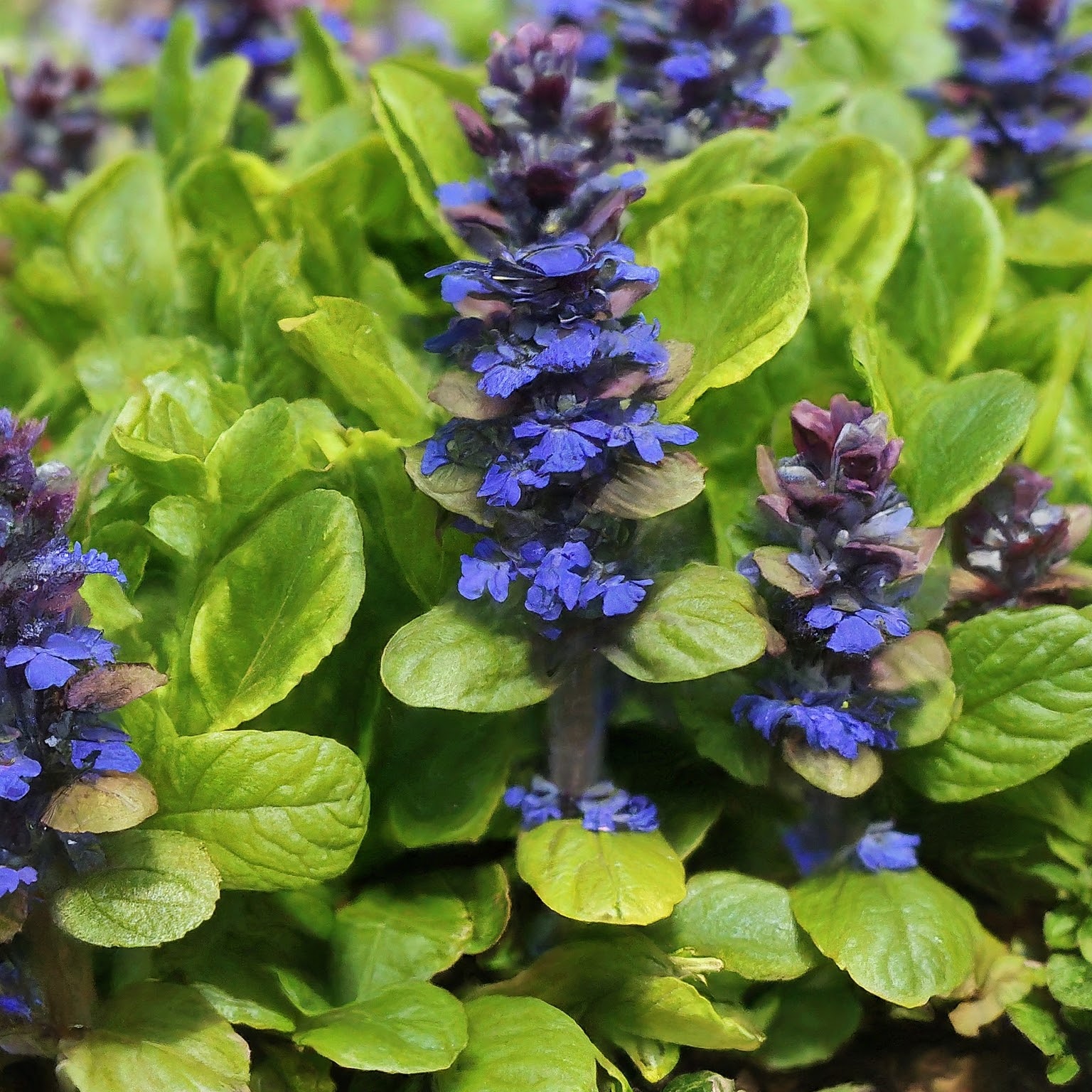Ajuga, often called ajuga reptant and bugleweed, is a perennial plant known for its vibrant foliage and attractive, spiky flowers. Native to Europe, Asia, and Africa, ajuga has become popular worldwide for its adaptability and low maintenance requirements.
With its stunning blue, purple, and white flowers that bloom in the spring and early summer, ajuga can brighten up any garden space. Its lush, evergreen leaves provide ground cover throughout the year, making it an excellent choice for both decorative and practical gardening.
Most people love this versatile plant, particularly for its ability to thrive in challenging garden spots. If you’ve struggled with finding plants that can grow well in shaded areas or those tricky patches under trees, ajuga might be your perfect solution.
It handles low light conditions gracefully and competes well with tree roots, making it a reliable ground cover in areas where other plants might falter. Plus, its dense mat of leaves helps suppress weeds, reducing the amount of maintenance required to keep your garden looking pristine.
Ajuga’s history is just as fascinating as its beauty.
Ancient people used ajuga in traditional medicine for its supposed healing properties.
The plant’s common name, bugleweed, reflects its historical use to treat respiratory and throat issues, thanks to its natural astringent qualities.
While it’s not commonly used medicinally today, ajuga’s presence in gardens across the world serves as a testament to its enduring appeal.
Whether you’re a seasoned gardener looking to fill gaps in your landscape or a newbie wanting to start your first garden, ajuga offers a charming and resilient option that can blend aesthetically appealing elements in your outdoor space.
Jump to a section:
- Ajuga Facts Table
- How to Grow and Care for Ajuga
- How to Propagate Ajuga
- Benefits of Ajuga Plant
- Pest and Disease Control
- Ajuga Types
- Bugleweed (Ajuga Reptans)
- Carpet Bugle (Ajuga Reptans 'Carpet Bugle')
- 'Black Scallop' Ajuga (Ajuga Reptans 'Black Scallop')
- 'Burgundy Glow' Ajuga (Ajuga Reptans 'Burgundy Glow')
- 'Chocolate Chip' Ajuga (Ajuga reptans 'Chocolate Chip')
- 'Dixie Chip' Ajuga (Ajuga reptans 'Dixie Chip')
- 'Silver Beauty' Ajuga (Ajuga Reptans 'Silver Beauty')
- Ajuga Companion Planting
- How and Where to Buy Ajuga Plant
- Ajuga Alternatives
- Conclusion
- FAQ
Ajuga Facts Table
| Feature | Details |
| Botanical Name | Ajuga reptans |
| Common Names | Bugleweed, Carpet Bugle |
| Family | Lamiaceae |
| Plant Type | Perennial |
| Mature Size | 6-9 inches tall, spreads up to 2 feet |
| Sun Exposure | Partial shade to full shade |
| Soil Type | Well-drained, moist soil |
| Soil pH | 6.0 to 7.0 |
| Bloom Time | Spring to early summer |
| Flower Color | Blue, purple, white |
| Hardiness Zones | 3-10 (USDA) |
| Native Area | Europe, Asia, Africa |
| Toxicity | Safer for humans, but keep away from pets |
How to Grow and Care for Ajuga
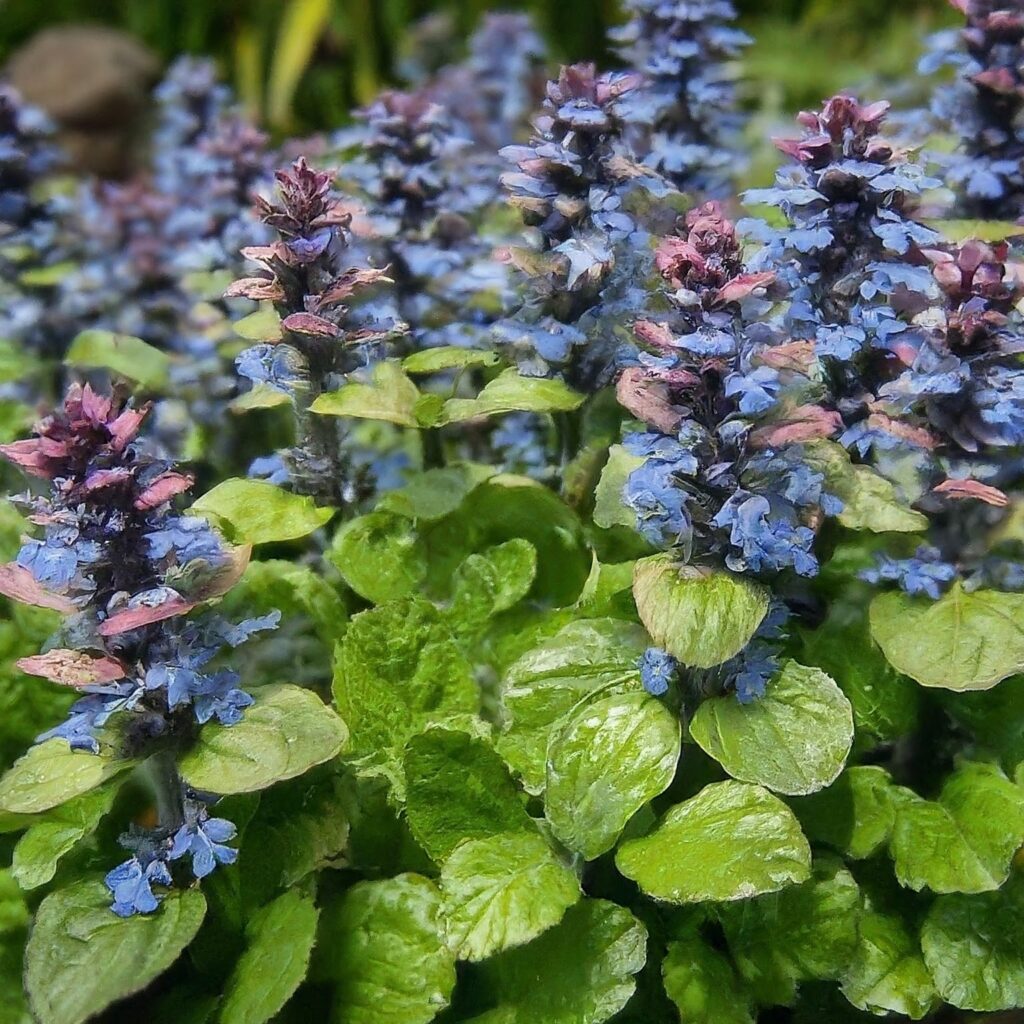
Ajuga is a rewarding plant for both novice and experienced gardeners.
Its low-maintenance nature, combined with its ability to thrive in various conditions, makes it an excellent choice for ground cover, borders, and even containers.
Here’s a detailed, step-by-step guide to help you grow and care for ajuga successfully.
1. Find a Healthy Ajuga Plant
When selecting an ajuga plant from a nursery or garden center, look for robust, well-developed specimens.
Healthy ajuga plants should have vibrant, unblemished leaves and a strong root system.
Avoid plants with yellowing leaves, signs of wilting, or any visible pests.
Bringing home a healthy plant sets a solid foundation for successful growth.
2. Light
Ajuga thrives in partial shade to full shade, making it an excellent choice for those tricky garden spots that don’t receive full sun.
However, understanding the nuances of light requirements will help you position your ajuga plants for optimal growth and health.
Partial Shade
In partial shade, ajuga receives filtered or dappled sunlight for a few hours each day, typically in the morning or late afternoon. This type of light condition mimics the plant’s natural habitat on forest floors, where it enjoys protection from the intense midday sun.
To achieve partial shade, you can plant ajuga under deciduous trees that provide light shade, along the north or east side of buildings, or in areas shielded by taller shrubs or structures.
Benefits of Partial Shade
- Protects the foliage from scorching in hot climates.
- Encourages lush, vibrant growth and healthy foliage.
- Reduces water evaporation, keeping the soil moist for longer periods.
Full Shade
Full shade refers to areas that receive less than three hours of direct sunlight per day, with the rest of the time being in indirect light or full shade.
Ajuga is well-suited to full shade conditions, making it a perfect choice for planting under dense tree canopies, in deeply shaded garden corners, or along shaded walkways.
Benefits of Full Shade
- Ideal for preventing leaf burn in particularly hot climates.
- Helps retain soil moisture, so you don’t have to water frequently.
- Creates a cool, serene garden environment that can be a respite from the heat.
Sun Tolerance
While ajuga is primarily a shade-loving plant, it can tolerate some direct sunlight, particularly in cooler climates.
If you live in an area with mild summers, your ajuga may do well in spots that receive morning sun or late afternoon sun, avoiding the harsh midday rays.
In such conditions, the foliage can develop more vibrant colors, especially in variegated varieties like ‘Burgundy Glow’ and ‘Black Scallop’.
Managing Sun Exposure
- Morning Sun: Ideal for ajuga as the light is gentle and not too intense. It also helps dry off the morning dew, reducing the risk of fungal diseases.
- Afternoon Sun: In cooler climates, ajuga can handle a few hours of afternoon sun, but in hotter regions, it’s best to provide shade during these hours to prevent stress and leaf scorch.
- Full Sun: In very cool climates, some ajuga varieties can tolerate full sun, but this is generally not recommended as it can lead to leggy growth and faded foliage color.
Adjusting Light Conditions
If your garden’s light conditions change throughout the year, for instance, due to the growth cycle of deciduous trees, you can adjust the light exposure for your ajuga plants:
- Spring and Fall: When trees are leafless, ajuga might receive more light. This can be beneficial as it stimulates growth after winter dormancy and helps the plant prepare for the cooler months ahead.
- Summer: As trees leaf out, providing shade, ajuga benefits from the protection against the intense summer sun, keeping the foliage lush and healthy.
Be sure to monitor the light conditions in different parts of your garden throughout the day to identify the best spots for planting ajuga. Use this information to strategically place your ajuga where it can thrive.
3. Watering
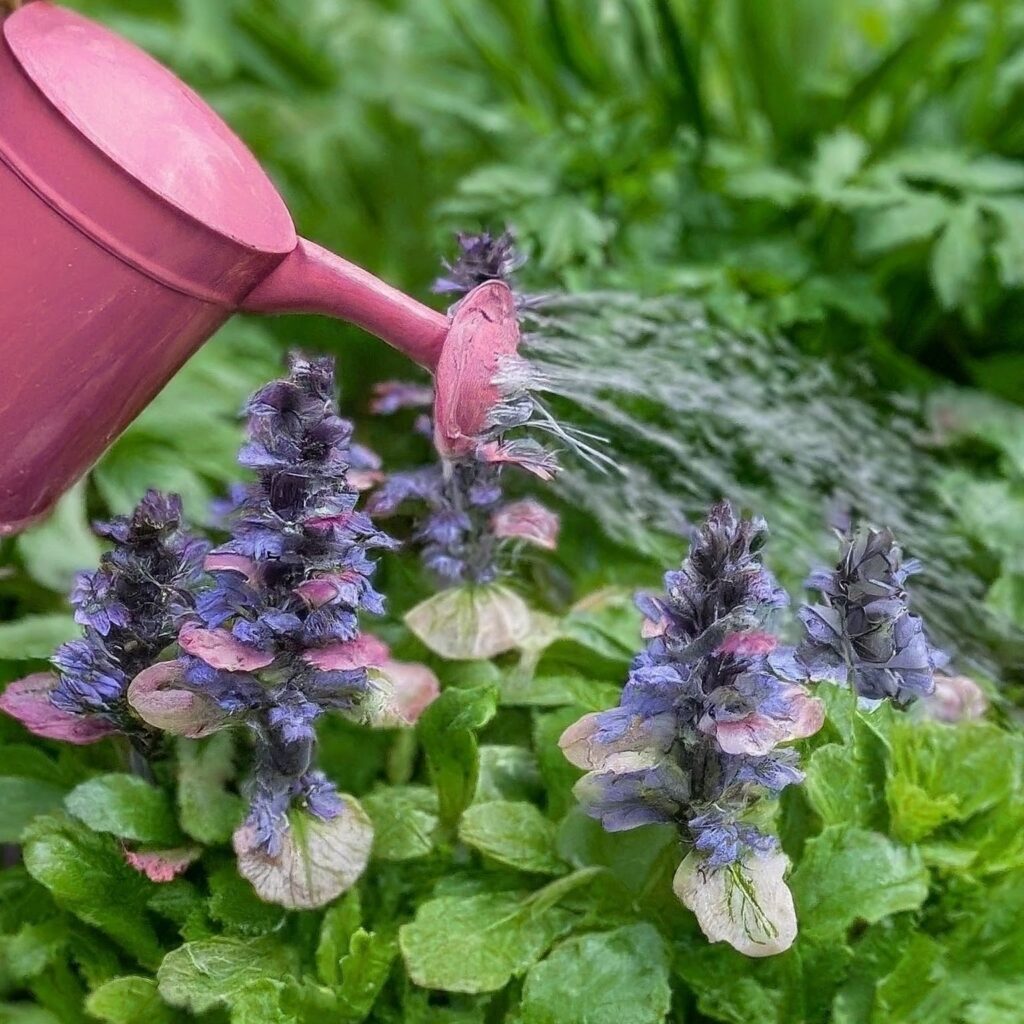
While ajuga is relatively low-maintenance, proper watering practices will help you achieve the lush, vibrant growth that makes this plant so appealing.
Consistent Moisture
Ajuga prefers consistently moist soil, but it’s important to strike a balance to avoid waterlogging, which can lead to root rot.
Here’s how you can maintain the right moisture levels:
- Regular Watering: During the growing season (spring and summer), keep the soil consistently moist. Water your ajuga deeply once or twice a week, ensuring the water penetrates down to the root zone.
- Adjusting Frequency: The frequency of watering can vary based on climate, soil type, and the specific growing conditions in your garden. In hotter climates, you may need to water more frequently, while cooler, more humid areas may require less.
Tip: Check the soil moisture by sticking your finger about an inch into the soil. Give it a drink when the soil feels dry.
Deep Watering
Deep watering encourages the roots to grow deeper into the soil, making the plant more drought-tolerant and resilient.
Here’s how to do deep watering:
- Slow and Steady: Water slowly and steadily, allowing the soil to absorb the water gradually. This prevents runoff and ensures the roots receive adequate moisture.
- Soak the Soil: Water until the top 6-8 inches of soil are thoroughly moistened. This deep soaking will support healthy root growth and prevent the plant from becoming dependent on frequent, shallow watering.
Mulching
Mulching around your ajuga plants can help retain soil moisture and reduce the need for frequent watering.
Top dress with natural mulches like shredded leaves, straw, or compost.
Here’s how mulching benefits your ajuga:
- Moisture Retention: Mulch helps keep the soil cool and moist by reducing evaporation, especially during hot weather.
- Weed Suppression: A layer of mulch acts as a natural weed barrier, blocking sunlight that weeds need to germinate.
- Temperature Regulation: Mulch acts as an insulating layer, protecting the roots from extreme temperature fluctuations.
Tip: Apply a 2-3 inch layer of mulch around your ajuga, but keep it a few inches away from the plant’s crown to prevent rot.
Seasonal Watering Adjustments
Ajuga’s watering needs change with the seasons.
Here’s how to adjust your ajuga watering routine throughout the year:
- Spring: As new growth emerges, increase watering to support the plant’s development. Provide consistent moisture, allowing for slight drying between waterings
- Summer: During the hot, dry months, water more frequently to prevent the soil from drying out. Early morning or late evening watering is best to minimize evaporation.
- Fall: Gradually reduce watering as temperatures cool and the plant prepares for dormancy. Maintain enough moisture to keep the soil from becoming completely dry.
- Winter: In areas with mild winters, ajuga may still require occasional watering if rainfall is insufficient. In colder regions, reduce watering significantly, as the plant’s growth slows down. Ensure the soil doesn’t stay waterlogged to avoid root rot.
Watering Newly Planted Ajuga
Newly planted ajuga requires special attention to ensure it establishes well in its new location:
- Initial Watering: Water thoroughly after planting to help settle the soil around the roots and eliminate air pockets.
- Establishment Period: For the first few weeks, water regularly to keep the soil consistently moist. This helps the roots establish and grow deeper into the soil.
- Gradual Reduction: Once the plant is established, typically after a month or so, gradually reduce the frequency of watering to encourage deeper root growth.
Overwatering and Underwatering
Both overwatering and underwatering can cause problems for ajuga:
- Overwatering: Too much water can lead to waterlogged soil, promoting root rot and other fungal diseases. Symptoms of overwatering include yellowing leaves, wilting, and a mushy crown.
- Underwatering: Insufficient water can stress the plant, leading to dry, crispy leaves and stunted growth. Prevent the soil from becoming bone dry.
Tip: Using a moisture meter can help you accurately gauge the soil moisture and adjust your watering schedule accordingly.
4. Temperature and Humidity
Ajuga is hardy in USDA zones 3-10, which means it can handle a wide range of temperatures.
However, it prefers moderate climates.
In hot, dry areas, additional watering and shade may be necessary to keep the plant healthy.
Ajuga also tolerates a range of humidity levels, although it thrives best in average humidity.
Improve air circulation around your plants to create a less hospitable environment for fungal diseases.
5. Growing Mix and Soil Requirement
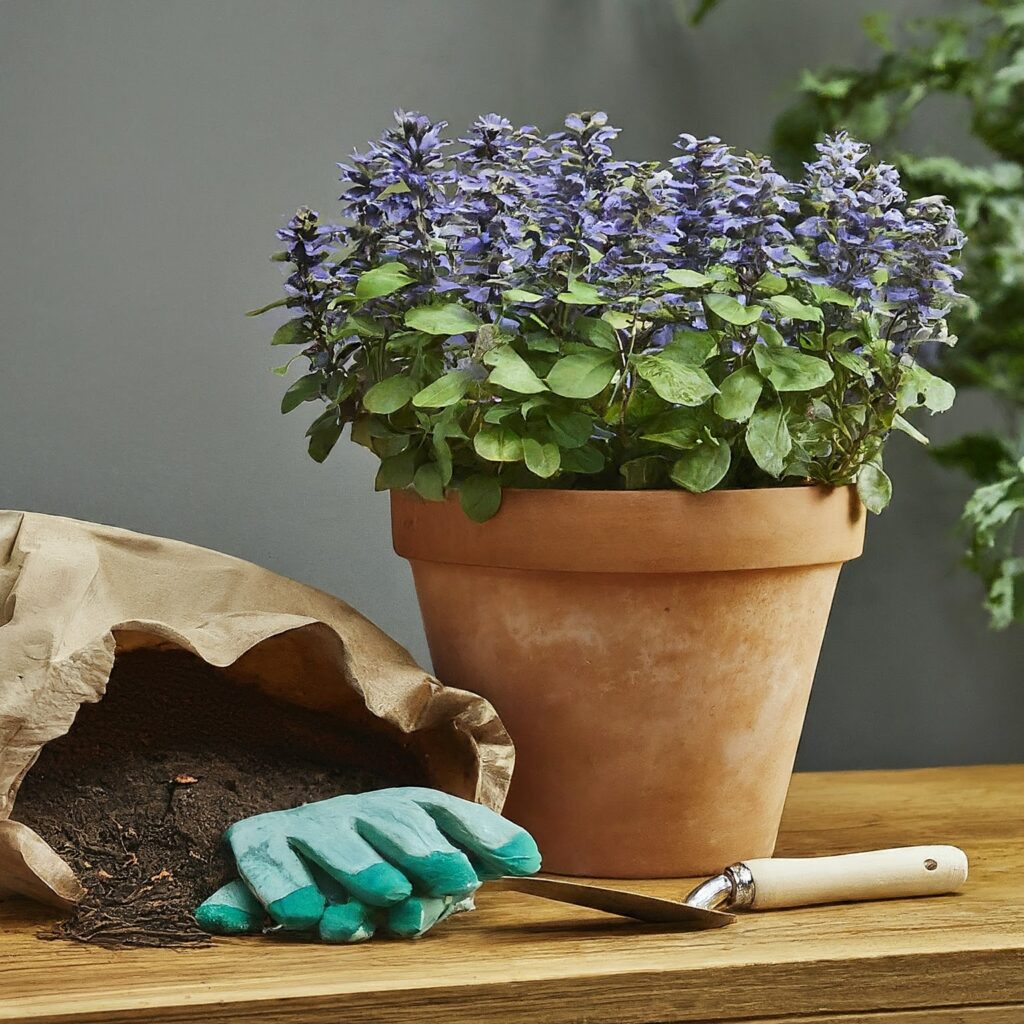
Ajuga is a versatile and resilient plant, but like all plants, it thrives best when planted in the right soil conditions.
Understanding the ideal soil requirements and making any necessary amendments will set the stage for your ajuga to grow vigorously and spread beautifully.
Here’s a detailed look at the growing mix and soil requirements for ajuga:
Soil Type
Ajuga is quite adaptable and can grow in a variety of soil types, but it has a preference for well-drained, loamy soils.
- Loamy Soil: This is the best type of soil for ajuga. Loamy soil is rich in organic matter, well-draining, and has a good balance of sand, silt, and clay. It retains moisture without becoming waterlogged, which is ideal for ajuga.
- Sandy Soil: While ajuga can tolerate sandy soil, it will require more frequent watering as sandy soil drains quickly and doesn’t retain moisture well. Adding organic matter, such as compost, can help improve water retention.
- Clay Soil: Ajuga can also grow in clay soil, but it’s important to ensure good drainage as clay tends to hold water and can become compacted. Mixing in organic matter or sand can improve drainage and soil structure.
- Silty Soil: This type of soil is fine and retains moisture well, but it can also be prone to compaction. Adding organic matter can help improve the structure and drainage of silty soil.
Soil pH
Ajuga prefers a slightly acidic to neutral soil pH, ideally between 6.0 and 7.0.
Here’s how to manage soil pH for your ajuga plant:
- Testing pH: Before planting ajuga, test your soil’s pH using a soil test kit. This will give you a clear idea of any adjustments needed.
- Adjusting pH: If your soil is too acidic (pH below 6.0), you can raise the pH by adding lime. If the soil is too alkaline (pH above 7.0), lower the pH by adding sulfur or organic matter like pine needles or composted leaves.
Check out this video on how to test your soil pH.
Soil Drainage
Good drainage is crucial for ajuga, as it helps prevent root rot and other fungal diseases. Here are some tips to ensure proper drainage:
- Soil Amendment: If your soil is heavy clay or compacted, improve drainage by mixing in organic matter such as compost, aged manure, or coarse sand. This action creates air pockets in the soil, allowing for better water movement and preventing root rot.
- Raised Beds: In areas with poor drainage, consider planting ajuga in raised beds. This elevates the root zone and allows for better drainage.
- Mulching: Apply a layer of mulch around your ajuga plants. It helps retain moisture and improves soil structure over time as it breaks down.
Organic Matter
Incorporating organic matter into the soil provides numerous benefits for ajuga:
- Nutrient Supply: Organic matter, such as compost or well-rotted manure, enriches the soil with essential nutrients that promote healthy growth and vibrant foliage.
- Improved Texture: Organic matter improves soil texture, making it easier for roots to penetrate and access water and nutrients.
- Microbial Activity: Healthy soil with plenty of organic matter supports beneficial microbial activity, which helps break down organic materials into nutrients that plants can absorb.
Preparing the Soil
Proper soil preparation before planting is key to ensuring your ajuga thrives.
- Clear the Area: Remove any existing weeds, unwanted plants, or pesky rocks from the designated area. This reduces competition for nutrients and water.
- Loosen the Soil: Before planting, loosen the soil 6-8 inches deep with a garden fork or tiller. This improves aeration and root penetration.
- Amend the Soil: Mix in a generous amount of organic matter, such as compost or well-rotted manure into the top 6-8 inches of soil.
- Adjust pH: Based on your soil test results, adjust the pH if necessary by adding lime to raise the pH or sulfur to lower it.
- Level the Area: Rake the soil surface smooth and level. This ensures even planting and prevents water from pooling in low spots.
6. Feeding
Ajuga isn’t a heavy feeder, but it does benefit from occasional fertilization.
In early spring, apply a balanced, slow-release fertilizer to support new growth and vibrant blooms. It is a good idea to feed your ajuga plant with a homemade nitrogen fertilizer.
In doing so, remember that too much fertilizer can lead to lots of leaves but fewer flowers, and might even stress the plant.
Organic options such as compost tea or fish emulsion can also provide gentle nourishment.
7. Repotting
If you’re growing ajuga in containers, we recommend repotting it every couple of years.
Select a pot slightly larger than the current one to provide room for growth. Plus, use fresh, well-draining soil to prevent root rot.
Repotting not only refreshes the soil nutrients but also gives you a chance to check the root health and trim any dead or damaged roots.
8. Deadheading
While deadheading isn’t essential for ajuga, it can help keep the plant looking tidy.
After the flowers fade, pinch or cut off the spent blooms.
This process can also prevent the plant from self-seeding excessively, which might be desirable if you want to control its spread.
9. Winter Care
Ajuga is hardy and can withstand cold winters, but in regions with harsh winters, additional protection might be necessary.
Apply a layer of mulch around the plants to insulate the roots from freezing temperatures. This layer can be removed in the spring to allow new growth to emerge.
In milder climates, ajuga often remains evergreen, providing year-round interest in your garden.
10. Pruning
Pruning ajuga is minimal but can help maintain its health and appearance.
In early spring, trim back any damaged or dead leaves before new growth starts.
If your ajuga patch becomes too dense, thinning it out can improve air circulation and reduce the risk of disease.
Regular pruning encourages healthy, vigorous growth and helps keep your garden looking neat.
How to Propagate Ajuga
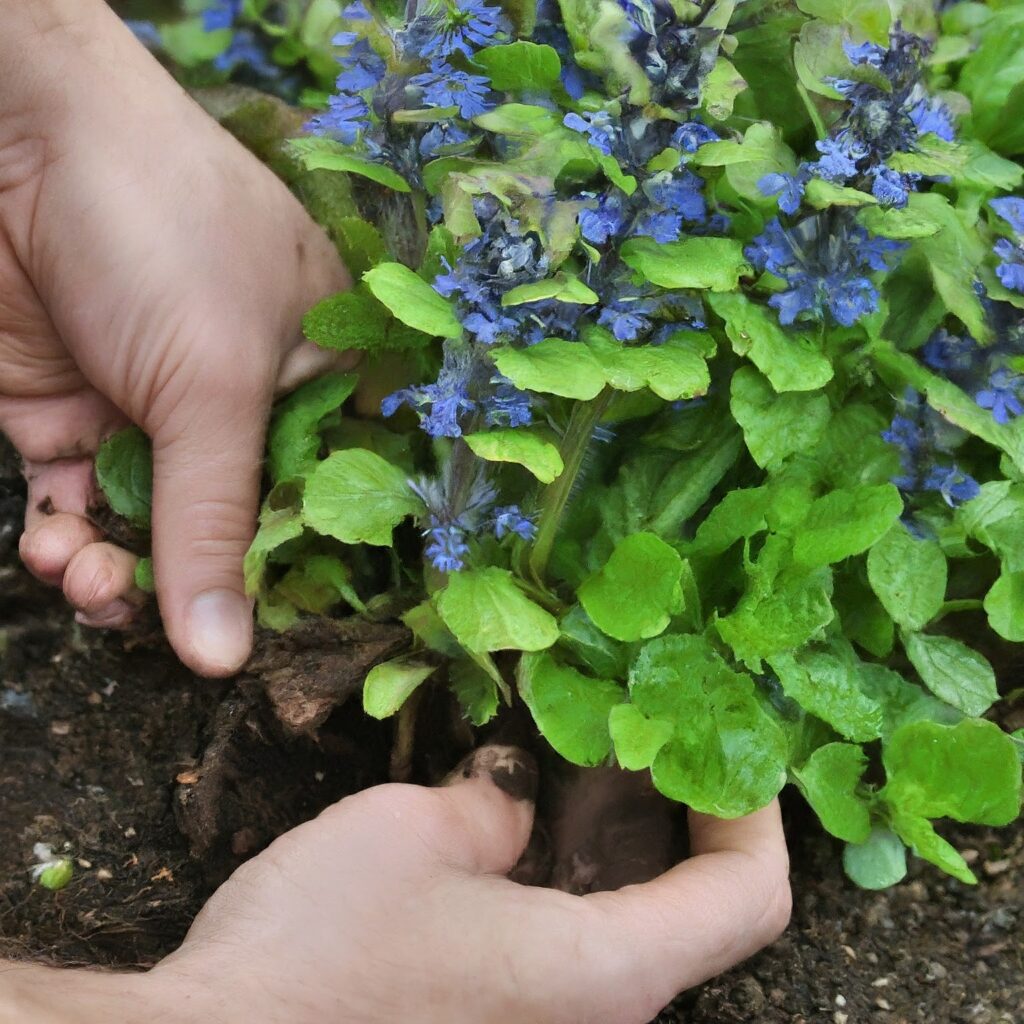
Ajuga is not only a beautiful and versatile plant but also relatively easy to propagate, making it a fantastic choice for gardeners looking to expand their ground cover.
The most common and effective method for propagating ajuga is through division.
Here’s when and how to propagate ajuga to ensure successful growth.
Best Time to Propagate Ajuga
Timing is crucial when propagating ajuga to give the new plants the best chance to establish and thrive. The optimal times for dividing and propagating ajuga are:
- Early Spring: Just as new growth begins, early spring is an ideal time to divide ajuga. The weather is cool, and the plants are starting their active growth phase, which helps them recover quickly from the division process.
- Early Fall: Late summer to early fall is another good period for propagation. The temperatures are cooler, and the soil is still warm, providing excellent conditions for the roots to establish before winter dormancy.
Growing Zones for Ajuga Propagation
Ajuga is hardy in USDA zones 3-10.
However, the exact timing of propagation can vary slightly depending on your specific climate within these zones.
Here’s how to adapt based on your growing zone:
- Zones 3-5: Propagate in late spring to early summer after the danger of frost has passed or in late summer to early fall.
- Zones 6-7: Early spring or early fall are the best times for propagation.
- Zones 8-10: Propagate in early spring or late fall to avoid the hottest months, which can stress newly divided plants.
Steps for Propagating Ajuga Through Division
Propagating ajuga through division is straightforward.
Follow these steps to ensure successful propagation:
Step 1: Prepare the Area
Choose the new planting location and prepare the soil as described in the growing mix and soil requirements section. Ensure the area is free of weeds and has well-draining, nutrient-rich soil.
Step 2: Water the Plant
A day before you plan to divide the ajuga, water the plant thoroughly. This ensures the roots are hydrated and less stressed during the division process.
Step 3: Dig Up the Plant
Using a garden fork or spade, carefully dig around the base of the ajuga plant you want to divide. Gently lift the plant out of the ground, being mindful not to damage the roots.
Step 4: Separate the Clumps
Once the plant is out of the ground, shake off excess soil to expose the roots. You’ll notice that ajuga grows in clumps, which are made up of several rosettes.
Use a sharp knife or your hands to separate these clumps into smaller sections. Each section should have several healthy leaves and a good root system.
Step 5: Prepare the Divisions
Inspect the divisions and trim away any damaged or dead roots. Healthy, vigorous roots are essential for successful propagation.
Step 6: Plant the Divisions
Dig holes in the prepared area that are slightly larger than the root ball of each division.
Place each division into a hole, ensuring that the crown (where the leaves meet the roots) is at soil level. Fill in with soil and gently firm it around the roots to eliminate air pockets.
Step 7: Water Thoroughly
After planting, water the divisions thoroughly to help settle the soil around the roots and provide the necessary moisture for establishment.
Step 8: Mulch
Apply a layer of mulch around the newly planted divisions to retain moisture, regulate soil temperature, and suppress weeds. Keep the mulch a few inches away from the crown to prevent rot.
Watch this video for the steps to propagate ajuga plant:
Care After Propagation
Newly divided ajuga plants need some extra care to ensure they establish well in their new location.
Here are some post-propagation care tips:
- Regular Watering: The key is to keep the soil evenly moist, but avoid letting it become waterlogged. Water regularly, especially during dry periods, to help the plants establish strong roots.
- Shade Protection: If propagating in spring or fall, ensure the new divisions are protected from intense sunlight. Temporary shade covers or planting in naturally shaded areas can help reduce transplant shock.
- Monitor Growth: Keep an eye on the new plants for the first few weeks. Remove any weeds that appear to reduce competition for nutrients and water.
Benefits of Propagating Ajuga
Propagating ajuga through division has several benefits:
- Cost-Effective: Propagation allows you to expand your garden without purchasing new plants.
- Plant Health: Dividing ajuga helps rejuvenate older plants by giving them more space to grow and access to nutrients.
- Garden Design: Propagation enables you to create a cohesive look in your garden by repeating plantings of ajuga in different areas.
Benefits of Ajuga Plant
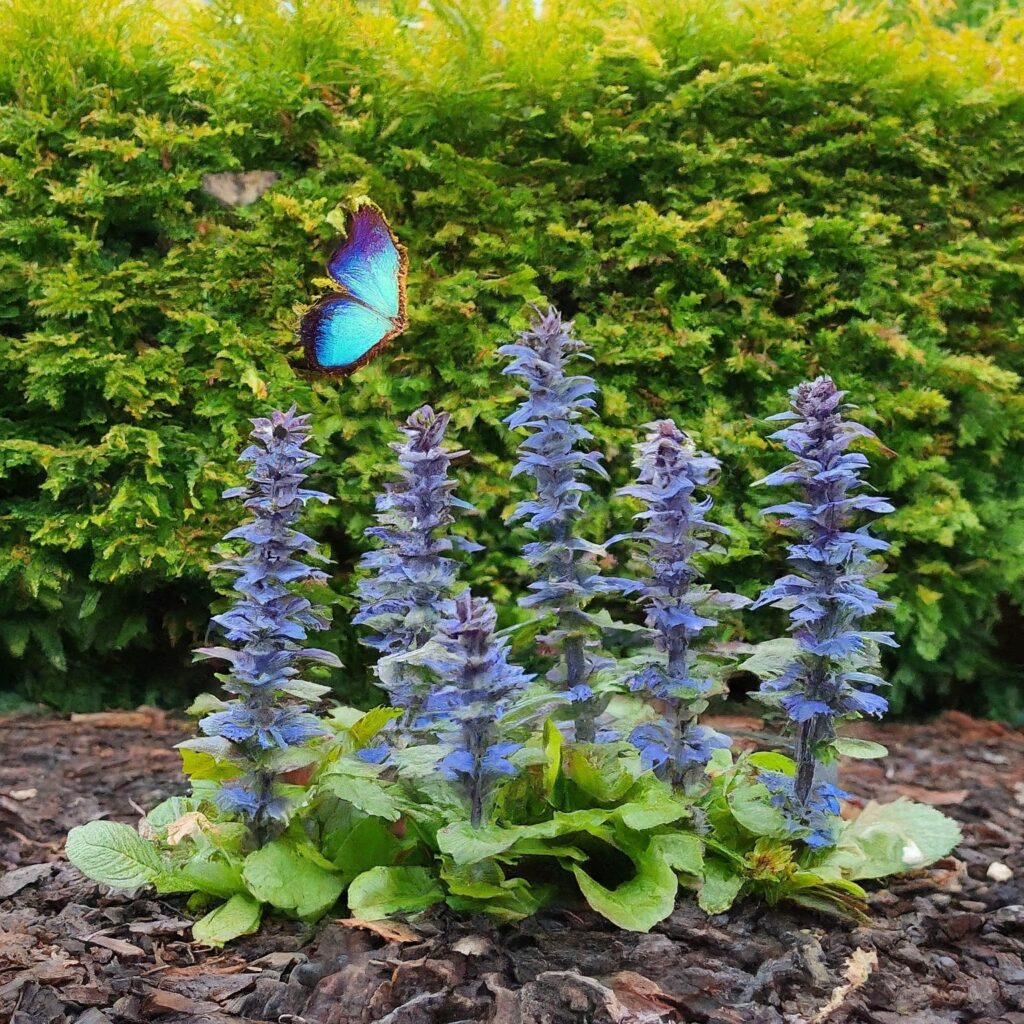
Beyond its aesthetic appeal, ajuga provides functional advantages that enhance garden health and biodiversity.
Erosion Control
One of the standout benefits of ajuga is its ability to control soil erosion.
Ajuga’s dense mat of foliage and extensive root system help stabilize the soil, making it an excellent choice for slopes, embankments, and other areas prone to erosion.
As the plant spreads, it forms a solid ground cover that holds soil in place, reducing the risk of erosion caused by wind and water. This is particularly beneficial in gardens with uneven terrain or areas that experience heavy rainfall.
Biodiversity Support
Ajuga plays a significant role in supporting local biodiversity. Its vibrant flowers attract a variety of pollinators, including bees, butterflies, and other beneficial insects.
Since it provides a food source for these pollinators, ajuga helps promote a healthy and balanced ecosystem in your garden.
Moreover, the dense foliage offers shelter and habitat for small wildlife, such as ground beetles and other beneficial insects that contribute to pest control. Growing ajuga in your garden can create a more dynamic and resilient environment, enhancing the overall health of your plants and supporting the local wildlife.
Check out this Reddit post with thoughtful insights on how to help ajuga spread more areas of your garden:
Weed Suppression
Ajuga’s ability to form a dense ground cover makes it an effective natural weed suppressant.
For example, a layer of mulch acts like a weed suppressor, preventing sunlight from reaching weed seeds and hindering their growth. This means less time spent battling weeds and more time enjoying your beautiful garden.
Plus, a weed-free garden bed looks more aesthetically pleasing and allows your desired plants to thrive without competition for nutrients and water.
Low Maintenance
Ajuga is a low-maintenance plant, making it ideal for busy gardeners or those new to gardening. Once established, ajuga requires minimal care. It is drought-tolerant, disease-resistant, and generally pest-free. Its ability to thrive in a variety of soil types and light conditions further reduces the need for constant attention and adjustment. By choosing ajuga, you can enjoy a lush, vibrant garden with minimal upkeep.
Seasonal Interest
Ajuga provides year-round interest in the garden.
In spring, it produces spikes of blue, purple, pink, or white flowers that add a splash of color and attract pollinators.
Throughout the growing season, its foliage remains attractive, with varieties offering different leaf colors and patterns, including deep green, burgundy, and variegated forms.
Even in winter, ajuga’s evergreen or semi-evergreen leaves add texture and color to the garden, ensuring that your landscape looks appealing in every season.
Ground Cover Versatility
Ajuga’s versatility as a ground cover is another notable benefit.
You can use it in many different garden settings, from shaded woodland areas and under trees to sunny borders and rock gardens.
You can even plant it between stepping stones, in container gardens, or as a lawn alternative in areas where traditional grass struggles to grow. Its adaptability makes ajuga a valuable plant for solving a range of landscaping challenges.
Watch the beautiful ground cover provided by ajuga in this video:
Pest and Disease Control
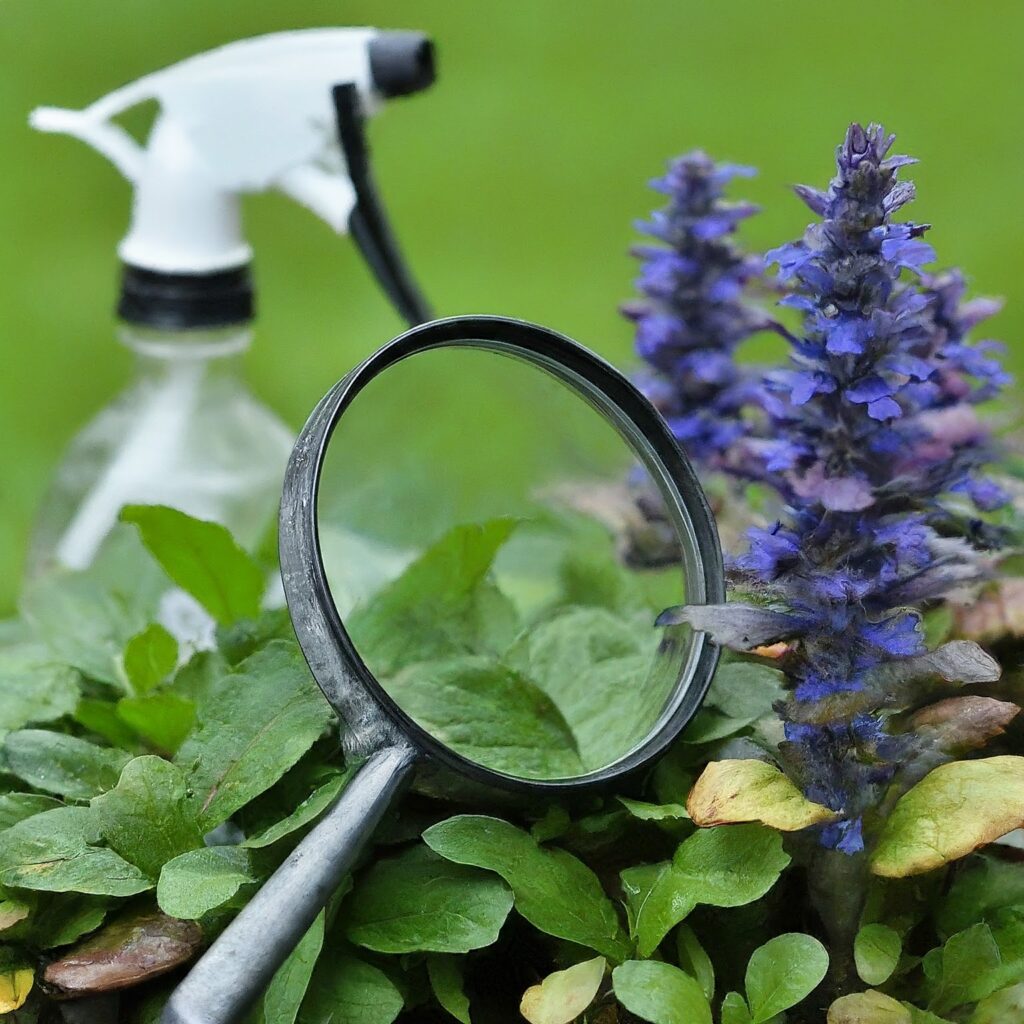
While ajuga is a resilient and relatively pest-free plant, it can occasionally face challenges from pests and diseases. Understanding common issues and implementing preventive measures will help you maintain healthy ajuga plants in your garden.
Common Pests
- Snails and Slugs: These mollusks can feed on ajuga leaves, leaving behind ragged edges or holes. To control snails and slugs, handpick them off your plants in the evening when they are most active. You can also use beer traps or apply diatomaceous earth around the base of your ajuga plants to create a barrier.
- Spider Mites: These tiny pests suck sap from the leaves, causing stippling and yellowing. Spider mites thrive in hot, dry conditions. To control them, regularly spray your ajuga plants with water to increase humidity and reduce spider mite populations. Also, it is a good idea to use eco-friendly, DIY pest control options like insecticidal soap or neem oil to control infestations.
- Crown Rot: Crown rot is a fungal disease that affects the base of the plant, causing the leaves to wilt and turn brown. This disease thrives in poorly drained soil and can be exacerbated by overwatering. To prevent crown rot, ensure your ajuga plants are planted in well-draining soil and avoid overwatering. Remove and dispose of the infected plant properly to prevent the disease from spreading to your other healthy plants.
Fungal Diseases
- Powdery Mildew: Powdery mildew is a fungal disease that shows up as a white, powdery coating on leaves. It loves humid environments and can weaken your plants if left unchecked. To control powdery mildew, improve air circulation around your ajuga plants by spacing them properly and avoiding overcrowding. Remove and destroy infected leaves, and consider applying fungicidal sprays if the problem persists.
- Root Rot: Waterlogged soil and fungal pathogens are the main causes of root rot. To prevent root rot, plant ajuga in well-draining soil and avoid overwatering. Suspect root rot? Don’t panic! Carefully loosen the soil and remove the plant to inspect its roots for any signs of disease. Then, trim away any mushy or discolored roots and replant in fresh soil.
Preventive Measures
- Proper Plant Spacing: Adequate spacing between ajuga plants promotes air circulation, reducing the risk of fungal diseases like powdery mildew. Follow recommended spacing guidelines when planting ajuga to prevent overcrowding.
- Watering Practices: Water ajuga plants at the base to avoid wetting the foliage, which can promote fungal diseases. Water early in the day to allow the foliage to dry before evening, reducing the risk of powdery mildew and other leaf diseases.
- Soil Drainage: Ensure your ajuga plants are planted in well-draining soil to prevent waterlogging and root rot. Amend heavy clay soil with organic matter to improve drainage and soil structure.
- Sanitation: Remove and destroy any infected or diseased plant material promptly to prevent the spread of pests and diseases. Clean gardening tools between uses to avoid transmitting pathogens between plants.
Natural Predators
Beneficial insects such as ladybugs, lacewings, and predatory mites feed on aphids, spider mites, and other pests that may affect ajuga plants.
Avoid using broad-spectrum insecticides that can harm beneficial insects and disrupt the natural balance in your garden.
Vigilance and Monitoring
Regularly inspect your ajuga plants for signs of pests and diseases, such as chewed leaves, stippling, wilting, or unusual discoloration. The key to healthy plants is spotting any issues early on.
Integrated Pest Management (IPM)
Integrated Pest Management (IPM) is an environmentally friendly approach to pest control that emphasizes prevention, monitoring, and intervention as needed.
Incorporate IPM practices into your gardening routine by combining cultural, mechanical, and biological control methods to manage pests and diseases effectively while minimizing the use of pesticides.
This holistic approach promotes long-term garden health and sustainability.
Ajuga Types
Ajuga encompasses several cultivars and varieties, each offering unique foliage colors, growth habits, and flower characteristics.
Whether you prefer rich green foliage, variegated leaves, or vibrant flower spikes, there’s an ajuga variety to suit every garden setting.
Here’s a detailed overview of some popular ajuga varieties:
Bugleweed (Ajuga Reptans)
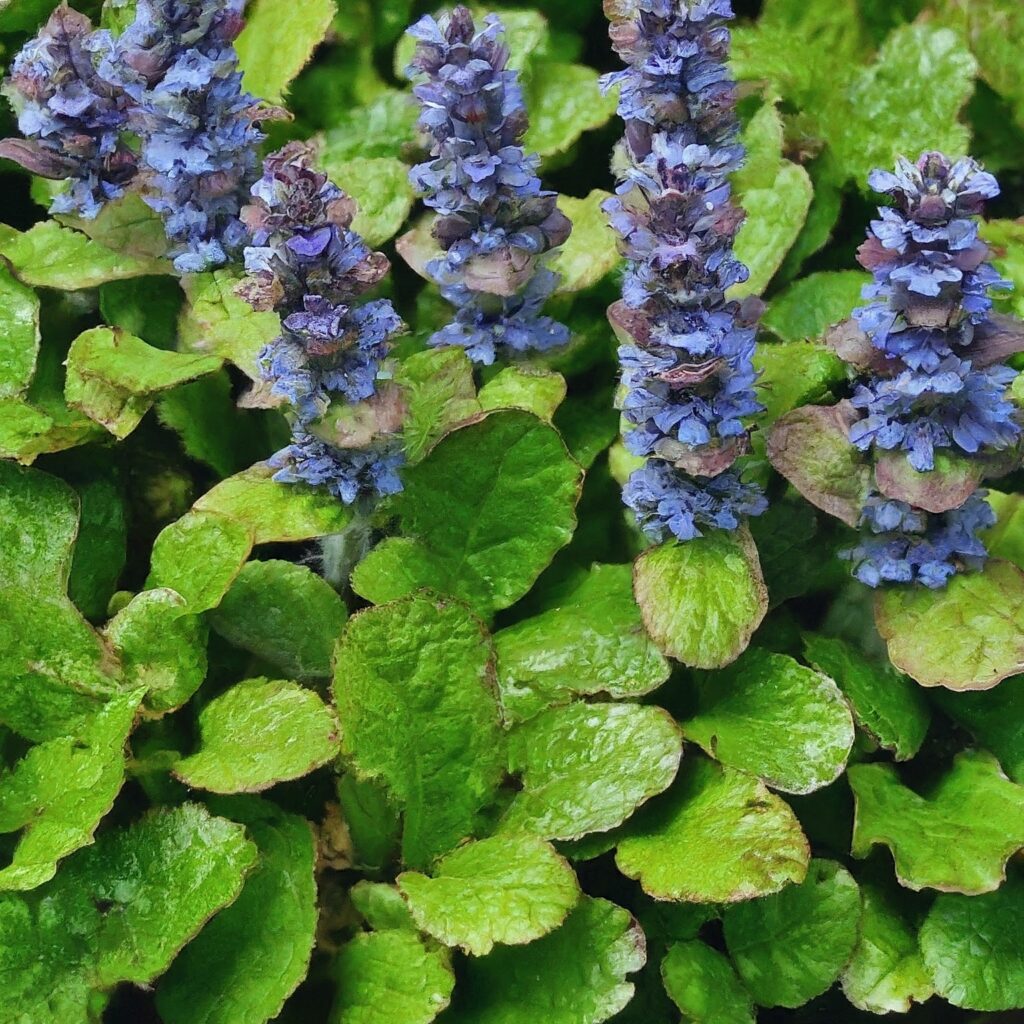
Bugleweed, the species plant of Ajuga reptans, is native to Europe but has become naturalized in various regions worldwide. It forms dense mats of glossy, ovate leaves that range in color from deep green to burgundy.
In spring, upright spikes of blue, purple, or white flowers rise above the foliage, attracting pollinators.
Bugleweed is prized for its versatility and adaptability, thriving in a range of light conditions from full shade to partial sun. It’s an excellent choice for ground cover in woodland gardens, under trees, or along the edges of borders and pathways.
Carpet Bugle (Ajuga Reptans ‘Carpet Bugle’)
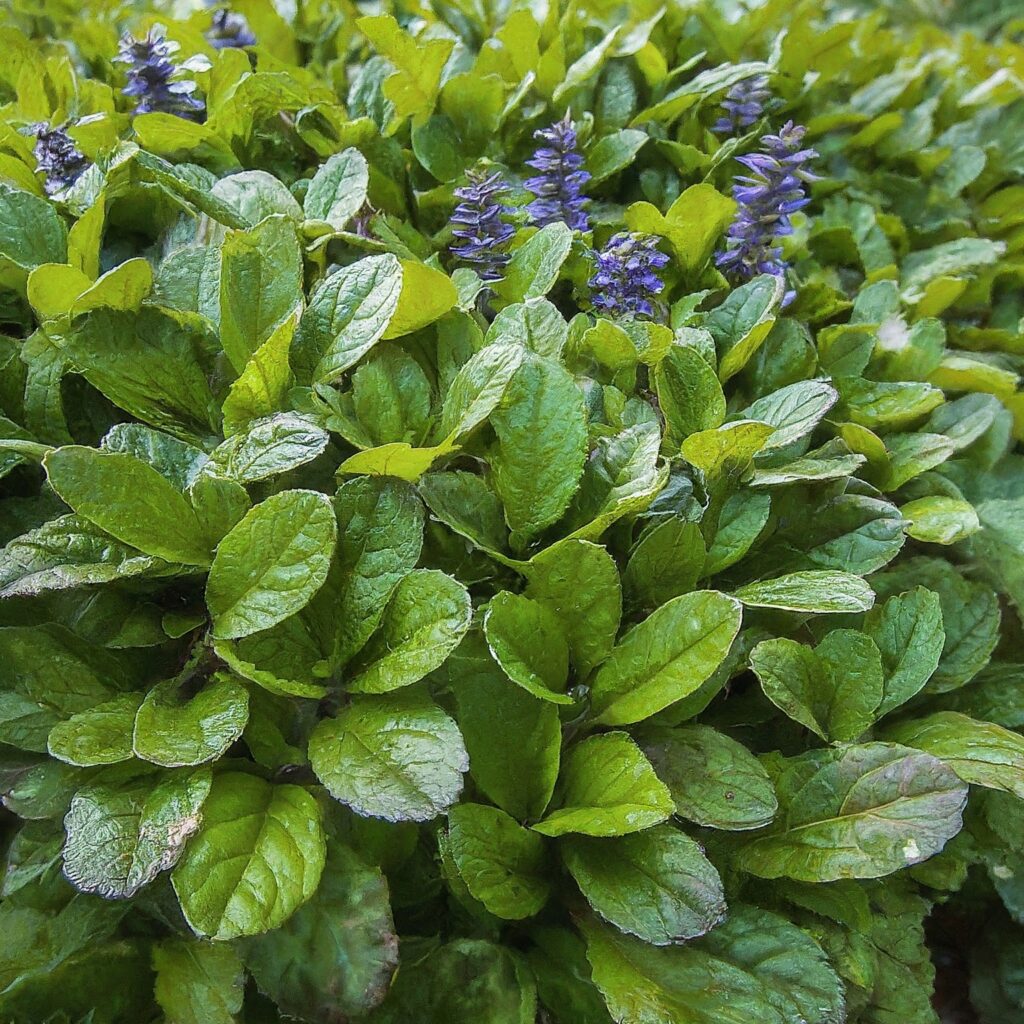
Carpet Bugle is a popular cultivar of Ajuga reptans prized for its low-growing habit and vigorous spreading nature. It forms a dense carpet of foliage, making it an excellent choice for ground cover in both sun and shade.
The leaves are typically dark green, though some varieties may exhibit bronze or burgundy tinges. Carpet Bugle produces short spikes of blue, purple, or white flowers in spring, adding a splash of color to the landscape.
This cultivar is known for its resilience and adaptability, making it a favorite among gardeners seeking a low-maintenance ground cover option.
‘Black Scallop’ Ajuga (Ajuga Reptans ‘Black Scallop’)

‘Black Scallop’ Ajuga is prized for its striking foliage, which features deeply scalloped, almost black leaves with a glossy sheen. The dark foliage provides a dramatic contrast in the garden and pairs beautifully with plants featuring lighter or variegated leaves.
In spring, ‘Black Scallop’ Ajuga produces short spikes of deep blue flowers that stand out against the dark foliage. This cultivar is tolerant of a range of light conditions, from full sun to partial shade, though it may exhibit the best coloration in partial shade.
‘Black Scallop’ Ajuga is an excellent choice for adding texture and visual interest to garden borders, rock gardens, or mixed container plantings.
‘Burgundy Glow’ Ajuga (Ajuga Reptans ‘Burgundy Glow’)
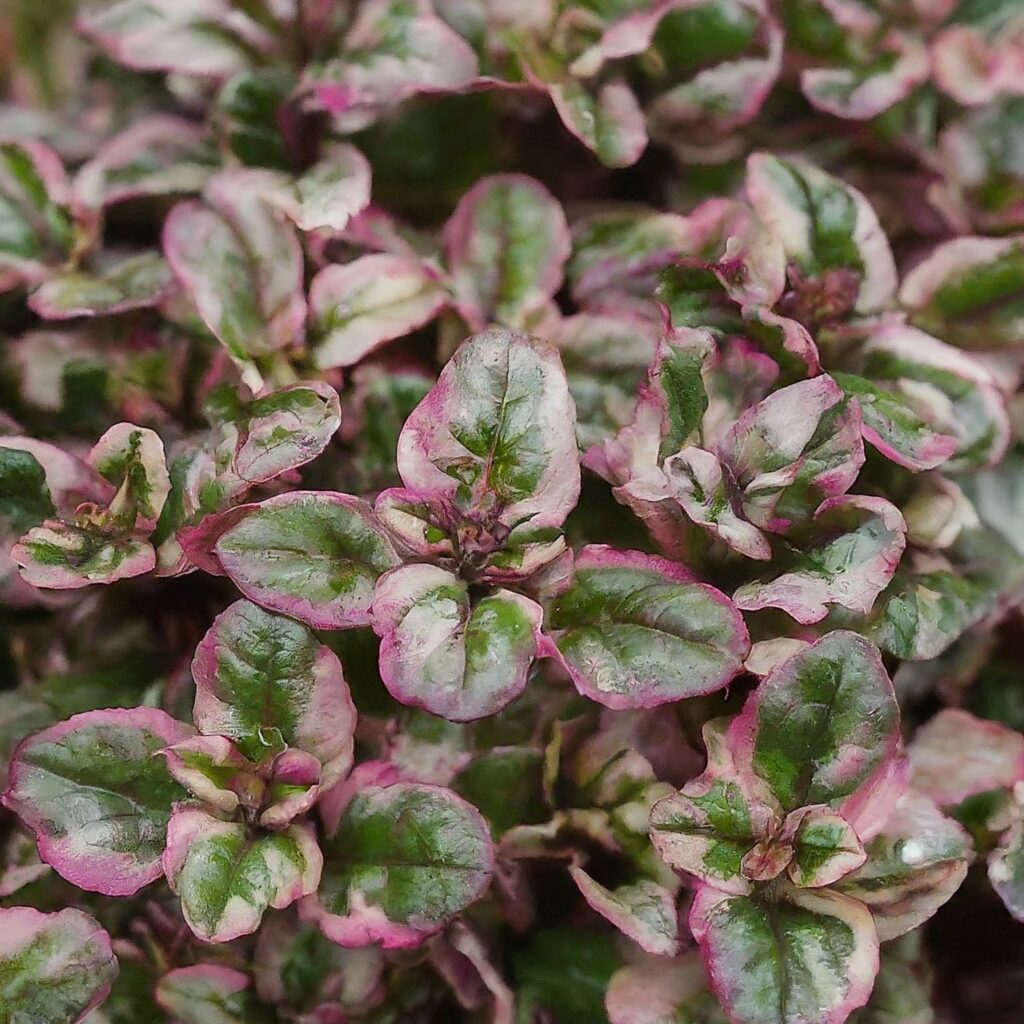
‘Burgundy Glow’ Ajuga is prized for its variegated foliage, featuring shades of green, cream, and pink, accented by burgundy highlights. The variegation intensifies in cooler temperatures, creating a vibrant tapestry of colors in the garden.
‘Burgundy Glow’ Ajuga produces spikes of blue flowers in spring. The flowers rise above the foliage, attracting pollinators. This cultivar is adaptable to a range of light conditions, though it may exhibit the best coloration in partial shade.
‘Burgundy Glow’ Ajuga is ideal for adding a pop of color to shaded garden areas, rockeries, or mixed borders.
‘Chocolate Chip’ Ajuga (Ajuga reptans ‘Chocolate Chip’)
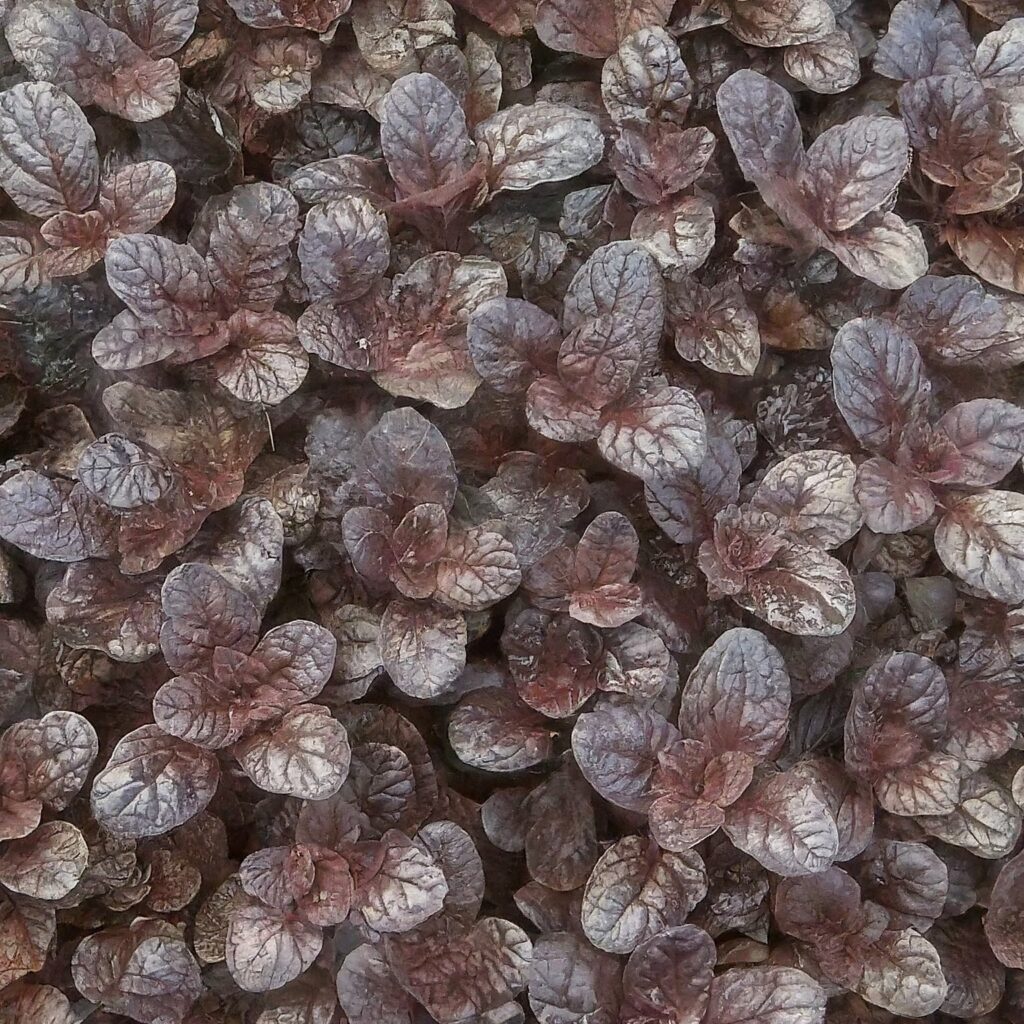
‘Chocolate Chip’ Ajuga is a compact cultivar prized for its diminutive size and finely textured foliage. The leaves are small, narrow, and a rich chocolate brown color, providing an elegant contrast to brighter plants in the garden.
In spring, ‘Chocolate Chip’ Ajuga produces short spikes of blue flowers that rise above the foliage, creating a charming display. This cultivar is well-suited to rock gardens, containers, or edging along pathways where its low-growing habit and attractive foliage can be appreciated up close.
This ajuga variety thrives in partial shade but can tolerate full sun with sufficient moisture.
‘Dixie Chip’ Ajuga (Ajuga reptans ‘Dixie Chip’)
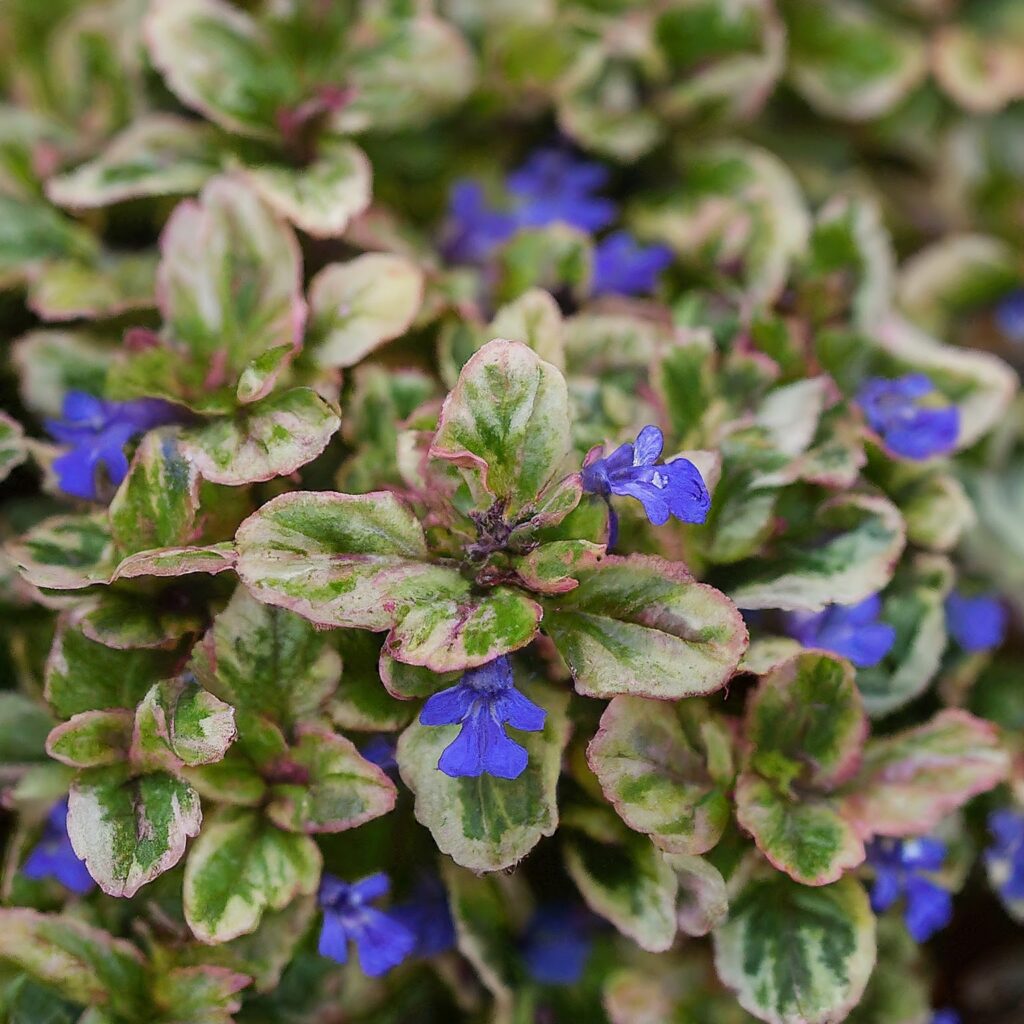
‘Dixie Chip’ Ajuga is a variegated cultivar prized for its eye-catching foliage and compact habit. The leaves are small and serrated, featuring shades of green, cream, and pink with hints of burgundy.
‘Dixie Chip’ Ajuga produces spikes of blue flowers that contrast beautifully with the variegated foliage. This cultivar forms dense mats of foliage, making it an excellent choice for ground cover in shady areas or beneath trees. ‘
This ajuga type is relatively low-maintenance and tolerant of a range of soil types, making it a versatile addition to the garden landscape.
‘Silver Beauty’ Ajuga (Ajuga Reptans ‘Silver Beauty’)
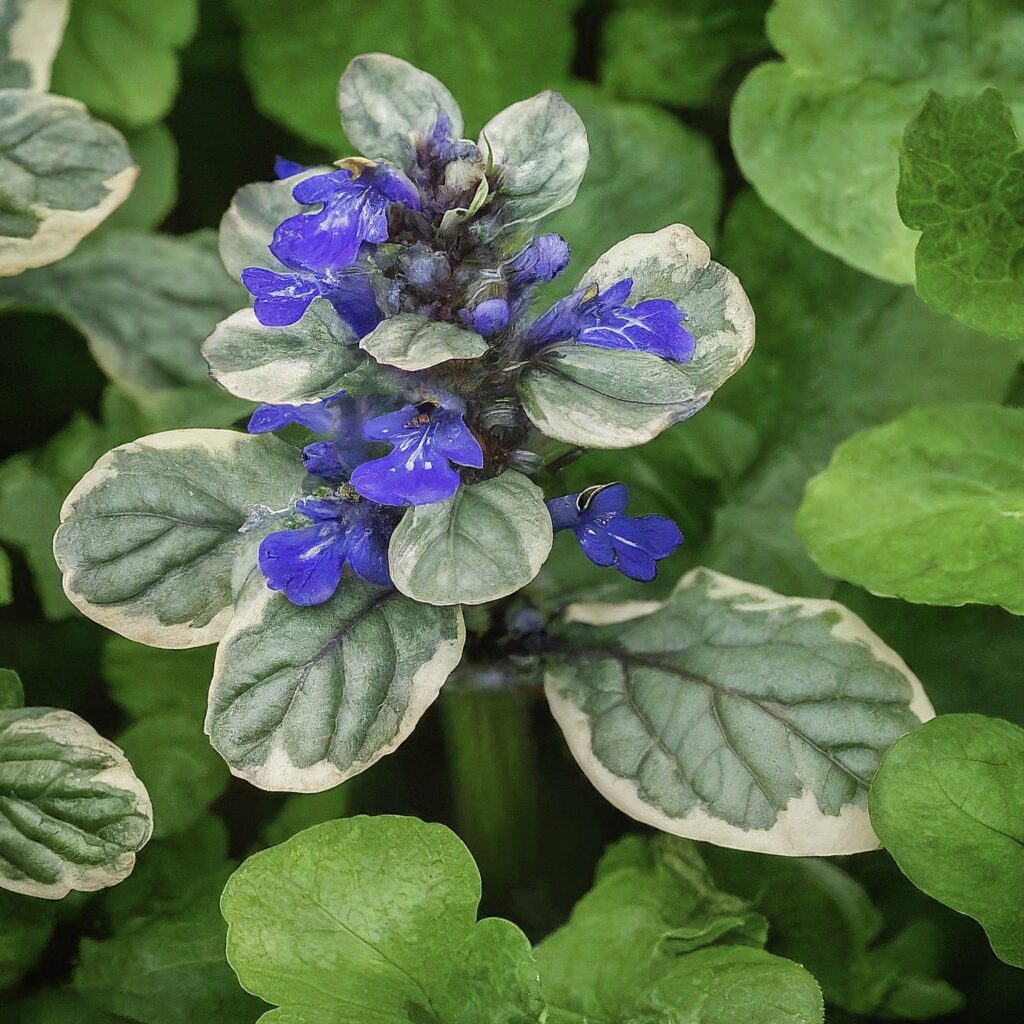
‘Silver Beauty’ Ajuga is valued for its striking silver-variegated foliage. It adds brightness and contrast to shaded garden areas. The leaves are oval-shaped with silver edges and green centers, creating a dynamic and eye-catching effect.
In spring, ‘Silver Beauty’ Ajuga produces spikes of blue flowers that rise above the foliage, attracting pollinators. This cultivar is adaptable to a range of light conditions, though it may exhibit the best coloration in partial shade.
Silver Beauty’ Ajuga is ideal for adding visual interest to woodland gardens, rockeries, or mixed borders where its silver foliage can shine.
Each ajuga type offers its own unique blend of colors, textures, and growth habits, allowing you to select the perfect variety for your garden’s specific needs and preferences.
Whether you’re seeking a low-maintenance ground cover, a splash of color in shady areas, or an eye-catching accent plant, there’s an ajuga variety to suit every garden setting.
Ajuga Companion Planting
Ajuga pairs well with several other plants, enhancing the beauty and health of your garden.
Here are four great companion planting options for ajuga:
- Hostas: Hostas thrive in similar conditions to ajuga, providing a lush, contrasting backdrop with their large, broad leaves.
- Ferns: Ferns add texture and height to the garden, complementing ajuga’s low-growing habit and creating a layered look.
- Heuchera (Coral Bells): Heuchera’s colorful foliage provides a striking contrast to ajuga, and both plants enjoy similar growing conditions.
- Astilbe: Astilbe’s feathery plumes of flowers add vertical interest and blend well with ajuga’s ground-hugging form.
How and Where to Buy Ajuga Plant
Ajuga plants are widely available at garden centers, nurseries, and online retailers.
When buying online, ensure the seller has good reviews and offers healthy, pest-free plants.
Local nurseries often have knowledgeable staff who can offer advice on the best varieties for your area.
Ajuga Alternatives
If ajuga isn’t quite right for your garden, consider these alternatives:
- Liriope: Also known as monkey grass, liriope is a tough ground cover with grass-like leaves and spikes of purple flowers.
- Vinca Minor (Periwinkle): Vinca Minor is a low-growing plant with glossy green leaves and blue or white flowers.
- Pachysandra: Pachysandra is a shade-loving ground cover with evergreen leaves and small white flowers.
- Lamium (Dead Nettle): Lamium has attractive foliage and pink, purple, or white flowers, making it a good alternative for shady areas.
Conclusion
Growing and caring for ajuga can be a rewarding experience, even for novice gardeners.
With its stunning foliage, vibrant flowers, and low-maintenance nature, ajuga is a versatile and resilient addition to any garden. Follow the tips and advice in this guide and you’ll be well on your way to enjoying a lush, beautiful ajuga-filled garden.
FAQ
What is ajuga used for?
Ajuga is primarily used as a ground cover due to its ability to spread quickly and create dense mats of foliage. It’s also popular in garden borders, rock gardens, and as an underplanting for shrubs and trees.
Is ajuga a sun or shade plant?
Ajuga thrives in partial shade to full shade but can tolerate some sunlight, especially in cooler climates. In hot areas, it performs best in shaded locations to prevent leaf scorching.
Is ajuga safe for pets and humans?
Ajuga is non-toxic to humans but can be toxic to pets if ingested in large quantities. Always monitor pets around garden plants and contact a veterinarian if you suspect ingestion.
Will ajuga choke out other plants?
Ajuga can spread aggressively and potentially choke out other plants if not managed properly. Regular pruning and monitoring can keep its growth in check and prevent it from overtaking other plants.
Does ajuga die back in the winter?
In colder climates, ajuga may die back in the winter, but it usually regrows in the spring. In milder climates, it often remains evergreen, providing year-round ground cover.
